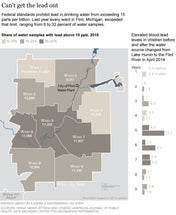Five years on, the Flint water crisis is nowhere near over

The Flint River scribbles 142 miles through mid-Michigan, and a noticeable change occurs as it flows southwest into the city of Flint. Concrete slopes capped with wire fences flank the water. Occasional graffiti or a weedy bush break the monotony of such barren shores. So do decaying bridge piers protruding from the center of the river like the sails of submarines much too large for the modest waterway.
Another stark transformation happens in the few seconds required to paddle beneath the Sunset Drive bridge. Gray stone ceases and a leafy, tree-shrouded corridor unfolds.
Looking back five years, the same magnitude of change happened on April 25, 2014, when smiling city officials raised glasses of water to toast a switch that altered 100,000 lives.
At that time, the city's water service changed from nearby Detroit's system to the local Flint River, in an effort to save money. But Flint failed to properly treat the water and dangerous levels of lead leached from old pipes, setting up a public health crisis that has endangered thousands of children and affected every resident, many of whom had to drink bottled water for long periods of time. Some still do. The political fallout was intense, with numerous city and state officials resigning. A city-declared state of emergency remains in effect as remediation continues, and skepticism persists when it comes to the drinking water quality. Many questions also linger about blame and the way the crisis unfolded, as well as about the community's connection to the river. (See portraits of the people living on bottled water.)


